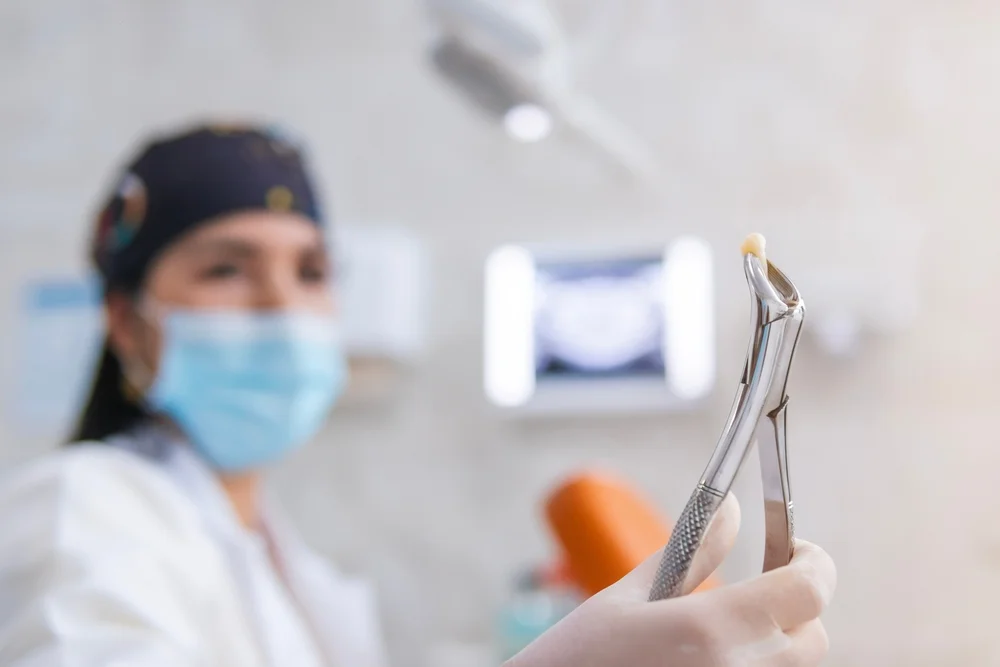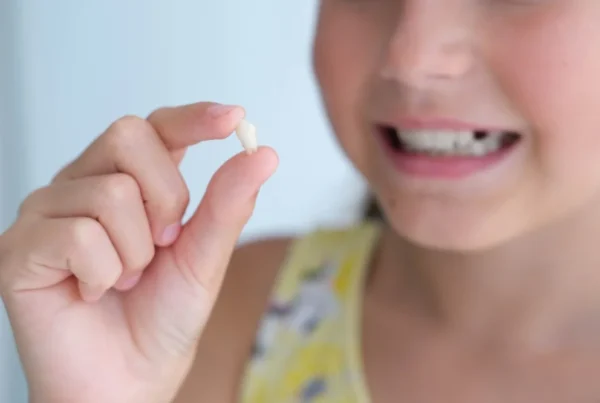Dry socket prevention requires protecting the blood clot that forms after extraction through careful post-operative care. This painful complication occurs in 2-5% of routine extractions but can be prevented with proper technique and patient compliance. Grand Prairie patients benefit from comprehensive prevention strategies including smoking cessation, gentle oral hygiene, and following specific aftercare instructions. Professional guidance and early intervention ensure optimal healing and prevent complications that could extend recovery time.
Preventing dry socket starts with understanding what it is and how it can be avoided. When a tooth is extracted, it leaves behind a socket, the hole in the bone where the tooth once was. Normally, a blood clot forms in this socket to protect the bone and nerves underneath while it heals. Dry socket occurs when this blood clot is dislodged or dissolves before the wound has a chance to heal, exposing the bone and nerves.
To avert this painful condition, three key prevention strategies should be considered: proper pre-extraction planning, careful post-extraction care, and patient education. Each strategy targets a specific aspect of dry socket prevention and requires collaborative effort from both the dental team and the patient.
Before an extraction, dental professionals need to evaluate and manage potential risk factors. This can include adjusting the extraction technique to minimize trauma to the socket and prescribing medications that may promote proper clot formation. After an extraction, it’s crucial to follow protocols such as gentle rinsing and avoiding negative pressure in the mouth.
Patients should be thoroughly educated about the risks, signs, and symptoms of dry socket. By addressing these areas systematically, the likelihood of developing dry socket can be greatly reduced.
Introduction
When it comes to tooth extractions, avoiding complications is as crucial as the procedure itself. Dry socket is one such complication that not only causes severe pain but can also significantly delay healing. To prevent this condition, our practice at Grand Prairie Family Dental focuses on three main areas: comprehensive preoperative care, delivery of clear postoperative instructions, and continuous patient support.
Preoperative care represents the first critical step in preventing dry socket complications. Our dental team carefully evaluates any factors that might increase risk and implements necessary precautions. This may include advising patients to avoid certain medications or habits that could impair clotting, ensuring a solid foundation for post-extraction recovery.
After the tooth has been removed, we provide patients with specific postoperative instructions designed to protect the extraction site. This includes advising against activities that create suction, like using a straw, that could dislodge the clot.
Patient support remains essential throughout the entire recovery process. Dr. Behrooz Khademazad’s 34 years of experience in Grand Prairie has shown that educating patients on the signs of dry socket and proper home care equips them to take an active role in their healing.
Understanding the Clinical Challenges of Dry Socket
Preventing dry socket involves more than a single solution and necessitates a comprehensive strategy aimed at addressing the multifaceted nature of its risk factors. Delving into the underlying challenges of this condition offers valuable insight into creating an effective prevention plan.
The technique used during extraction plays a pivotal role in the development of dry socket complications. Therefore, it is essential for dental professionals to execute the procedure with precision and skill, minimizing the disturbance to tissues adjacent to the extraction site. Precision in technique helps preserve the integrity of the blood clot that forms naturally in the socket.
An equally important aspect is the patient’s post-surgical behavior and compliance with instructions. The full cooperation of the patient in observing aftercare instructions is imperative to prevent complications. Strict adherence to guidelines like avoiding smoking or rigorous rinsing can greatly influence the healing trajectory and prevent dry socket complications.
Mitigating the risk of dry socket successfully relies on a collaborative dual approach. The dentist’s skill in minimizing surgical trauma, combined with the patient’s commitment to follow postoperative care instructions, creates an environment conducive to healing and markedly diminishes the possibility of this challenging post-extraction complication.
Risk Factors Within Patient Control
To effectively safeguard against the development of dry socket, patients must recognize and manage their controllable risk factors proactively. Patients’ lifestyle choices and behaviors notably influence their recovery outcomes post-tooth extraction, making patient education and compliance crucial for prevention success.
Smoking cessation represents one of the most significant actions a patient can take to reduce the risk of dry socket. The act of smoking can create negative pressure, which has the potential to dislodge the protective blood clot at the extraction site. Additionally, the harmful chemicals in tobacco products can disrupt the natural healing process and introduce contaminants to the wound.
Key controllable risk factors include:
- Complete smoking cessation for at least 48-72 hours before and after extraction
- Avoiding drinking through straws or creating suction in the mouth
- Gentle oral hygiene practices that protect the extraction site
- Following prescribed medication schedules exactly as directed
- Maintaining proper nutrition to support the body’s healing processes
Maintaining proper oral hygiene becomes another crucial consideration for patients during recovery. Following tooth extraction, patients should gently cleanse the oral cavity without disturbing the site, avoiding vigorous rinsing or spitting that could compromise clot integrity.
Strict adherence to aftercare protocols including rest, proper nutrition, and prescribed medication plays an indispensable role in the healing process. Grand Prairie Family Dental emphasizes the significance of these guidelines, assisting patients to navigate their recovery with informed choices.
Addressing Biological and Demographic Predispositions
To comprehensively tackle the risk of developing dry socket, it is essential to consider individual biological and demographic factors that could predispose a patient to this condition. Tailored strategies are pivotal for those at greater risk, ensuring personalized care that addresses each patient’s unique circumstances.
Hormonal fluctuations are known to have a noteworthy effect on healing, and this is especially true for women on oral contraceptives. The hormonal changes associated with these contraceptives may affect blood clot stability, thereby increasing the risk of dry socket development. Recognizing this increased risk, personalized advice regarding optimal scheduling of dental procedures can be provided.
In addition to hormonal influences, factors like age and overall health also play significant roles in the healing process. Younger patients often heal more rapidly due to higher regenerative abilities, whereas older individuals or those with compromised immune systems may be advised to take additional precautions post-extraction.
At Grand Prairie Family Dental, understanding these personal health variables informs our prevention protocols and treatment planning. By considering each patient’s unique health background and lifestyle factors, we can offer customized guidance and care plans designed to effectively mitigate the likelihood of experiencing dry socket following extraction.
Our Proactive Strategy for Dry Socket Prevention
At Grand Prairie Family Dental, we understand that preventing dry socket is far more effective than treating it after it occurs. Our approach is defined by proactive measures, patient collaboration, and a commitment to education that begins before surgery and continues through the entire recovery process.
The cornerstone of our preventive approach is the close partnership we foster with our patients from the initial consultation. Well before the surgical procedure, our team engages with patients, setting the stage for trust and cooperation throughout treatment. This relationship allows us to tailor our guidance to each individual’s situation, ensuring they are fully prepared for prevention steps.
Education forms a critical component of our comprehensive prevention strategy. We devote time to informing patients about the nature of dry socket, the risk factors, and the crucial role they play in their own healing process. By understanding the reasoning behind each instruction, patients are more likely to comply with our recommendations for post-surgical care.
Our proactive strategy extends into the post-operative period, where we reinforce the importance of the guidelines provided during recovery. We discuss each aspect of care, from medication adherence to proper oral hygiene practices, confirming that patients are equipped with the knowledge to promote swift and uncomplicated healing.

Key Triggers and When to Seek Help
Identifying early symptoms of dry socket is essential for timely intervention and preventing more severe complications during recovery. Our team at Grand Prairie Family Dental emphasizes the need for patients to be aware of key triggers indicative of potential issues during their healing process.
Understanding the symptoms represents the first step in recognizing complications early. Pain that intensifies after tooth extraction, visible loss of the blood clot at the tooth site, and an unpleasant taste or odor emanating from the socket are all tell-tale signs that warrant immediate attention. Our pre and post-operative discussions with patients underscore these symptoms to ensure they remain informed and vigilant.
Additionally, we have established a proactive follow-up routine that utilizes digital tools to maintain consistent communication with our patients. This engagement is not only reassuring to them but also enables us to monitor their status and provide immediate advice or care as needed during recovery.
If any of these symptoms present themselves, patients are advised to reach out to our office without delay. Prompt treatment is often the key to a quick recovery and minimizes the risk of further complications. Our practices reflect our philosophy of being proactive rather than reactive to safeguard patient well-being during recovery.
Access to Resources and Expert Advice
To ensure the success of our aftercare program, Grand Prairie Family Dental provides continuous support and educational resources throughout recovery. We build a foundation for patient empowerment, enabling them to contribute effectively to their post-operative recovery and healing process.
Our resources include detailed home care instructions that explain what patients should do in the days following their procedure. From how to properly clean the area without disturbing the clot to managing pain and minimizing swelling, these guidelines are crafted to be easy to understand and follow, ensuring each patient can take an informed role in healing.
Moreover, we believe in the importance of immediate access to professional advice should concerns or questions arise. By offering multiple channels of communication, such as phone lines, email, and digital messaging, we ensure that patients receive timely responses to their inquiries, reinforcing the safety net of our aftercare services.
The true measure of our commitment to patient care is reflected in our readiness to provide support at every stage of the recovery process. This access to resources and expert guidance not only facilitates a smooth recovery but also instills confidence in patients, enabling them to manage their recovery proactively and with assurance throughout the healing journey.
Comprehensive Preventive Measures
The prevention of dry socket at Grand Prairie Family Dental comprises a set of carefully curated practices that together establish a robust healing regime. Our protocol is designed to reinforce the body’s natural healing processes and reduce the risk of complications that could delay recovery or cause additional discomfort.
An integral part of our preventive measures is the use of therapeutic mouth rinses prescribed by our dental professionals. These rinses are formulated to be gentle on the extraction site while providing an antiseptic benefit. By using these as directed, patients can help maintain a clean environment conducive to healing, which is essential for preventing dry socket development.
Essential preventive measures include:
- Using prescribed therapeutic mouth rinses as directed
- Avoiding smoking and tobacco products completely during healing
- Making dietary changes to support healing and avoid site trauma
- Following proper rest protocols to allow optimal recovery
- Scheduling and attending follow-up appointments as recommended
In tandem with therapeutic rinses, we advocate for lifestyle modifications that are critical during the recovery phase. For example, avoiding smoking and making dietary changes can significantly impact the healing process in a positive manner. Simple changes like these can greatly aid in the formation and maintenance of a blood clot at the extraction site.
By adhering to these comprehensive measures, our patients at Grand Prairie Family Dental experience fewer incidents of dry socket. Our approach not only minimizes the risk of this painful condition but also promotes a swifter and more comfortable recovery.
Conclusion
The approach at Grand Prairie Family Dental to dry socket prevention is both proactive and holistic, rooted in a philosophy that champions patient empowerment and collaborative care. Success in preventing dry socket is a testament to the efficacy of our comprehensive care model and our dedication to quality patient outcomes.
Our proactive measures serve as the first pillar of this approach, ensuring that prevention begins well before any signs of dry socket could appear. We engage our patients in a plan tailored to their individual needs, enabling them to take active control of their recovery and minimizing the risk of complications that could extend healing time.
Dr. Behrooz Khademazad’s 34 years of experience in Grand Prairie has demonstrated that a holistic strategy, integrating education, resources, and support, treats the whole patient and not just the surgical site. This well-rounded care supports swift and smooth recoveries, reflecting our unwavering commitment to top-tier dental care. Grand Prairie Family Dental’s patient-first approach emphasizes the collective role of both dentist and patient in ensuring optimal outcomes, creating a synergy that prevents dry socket while providing an experience that instills confidence and fosters health long after patients leave our office.
Schedule your consultation today with Dr. Behrooz Khademazad and discover what personalized dental care in Grand Prairie, TX truly feels like.
Schedule Your Consultation Today!
Grand Prairie Family Dental
2475 W Pioneer Pkwy Grand Prairie, Texas, 75051
Google Reviews: See More Reviews From Grand Prairie Family Dental
View information about local places in our community.
Driving Directions to Our Practice
Frequently Asked Questions
What causes dry socket after a tooth extraction?
Dry socket occurs when the protective blood clot at an extraction site is dislodged or dissolves prematurely, exposing the underlying bone and nerves. It can be caused by actions like smoking, using straws, vigorous rinsing, poor oral hygiene, or not following proper aftercare instructions. Certain factors like hormonal changes, age, and overall health can also increase the risk of developing this painful condition.
How can I tell if I have dry socket?
Signs of dry socket include severe, throbbing pain that typically begins 2-3 days after extraction and may radiate to your ear or neck. You might see visible bone in the empty socket where the tooth was removed, experience an unpleasant taste or smell from the extraction site, or notice that the pain doesn’t improve with prescribed pain medication. Contact your dentist immediately if you suspect dry socket.
How does Grand Prairie Family Dental prevent dry socket?
We focus on comprehensive preventive care that includes thorough preoperative planning, precise extraction techniques, detailed aftercare instructions, and ongoing patient education. Our approach includes evaluating individual risk factors, providing therapeutic mouth rinses, offering multiple communication channels for support, and maintaining follow-up protocols. We emphasize patient education about risk factors and the critical importance of following post-surgical self-care instructions to ensure optimal healing.
Related Articles
Learn More About:






